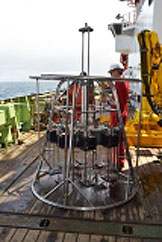This morning, as we headed for Goban Spur, we were accompanied by a pod of common dolphin. Keeping pace easily with the ship, they jumped and flew through the choppy surface waters.

Once on station, the crew set to work deploying the conductivity, temperature and depth (CTD) sensor array on a metal frame also equipped with a rosette of 24 sampling bottles that is lowered into the ocean. The CTD enables collection of water samples at different depths in the water column along with data collected by the sensors. Once collected, the samples are analysed for levels of dissolved inorganic carbon and plant pigments. The taxonomy of the phytoplankton is determined using flow cytometry, light microscopy and scanning electron microscopy.
This afternoon we deployed a mega corer to collect sediment samples from the sea floor 1,000 m below. The team is interested to learn more about how nutrient levels in surface waters can influence deep sea ecosystems. We will use the mega corer to sample animals, hopefully polychaete worms that live and feed on the sea floor sediment. The team will try to uncover how the ecology of these worms is affected by changes in the levels of marine snow, the small particles of dead and decaying matter that rains down into the deep from surface waters.
To maximise the efficiency of storage and retrieval of our data, Leighton Rolley, the Science System Support Technician has devised an electronic event logger. Developed in 2011, the event logger links data collected by the Cook’s multiple sensors with the data collected during experiments undertaken on board.
As the evening approaches, the team await retrieval of the day’s second mega core. Work will continue into the night.

